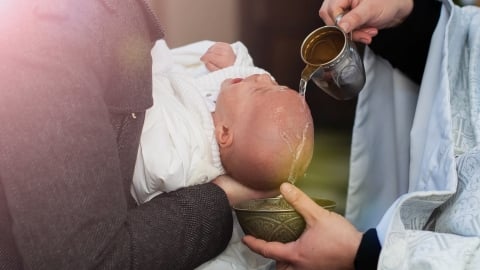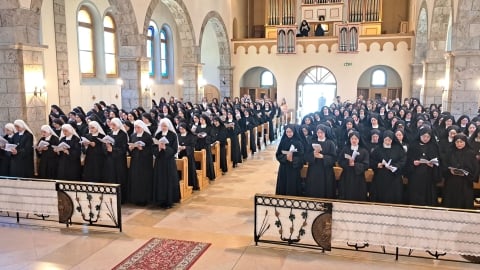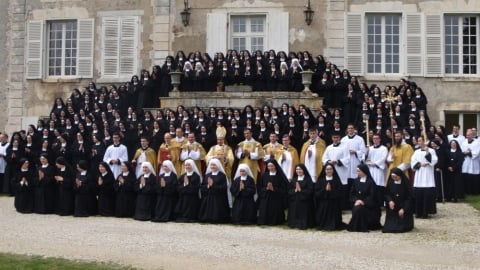How the crisis impacts priests, family, vocations

An interview of Fr. du Chalard covers the topics of how the post-conciliar crisis has affected the priesthood, families, vocations and more recently, the FFI.
We are grateful to our District of Italy for allowing us to offer the English version of Fr. Sbicego's interview with long-time editor of SiSiNoNo, Fr. Emmanuel du Chalard.
Interview with Fr. du Chalard: Archbishop Lefebvre and the priesthood; the crisis of the men of the Church; the Franciscans of the Immaculate, etc…
I recently had the opportunity to interview Fr. Emmanuel du Chalard on some questions that are currently getting a good deal of attention: Archbishop Lefebvre and the priesthood; the crisis of the men of the Church; the Franciscans of the Immaculate and the same order’s congregation of nuns; but also on the mission in Asia and the traditional religious life. I wish to start by thanking him for his generosity in answering me even though he was traveling to India at the time.
Fr. Massimo Sbicego: Fr. Chalard, you were one of Archbishop Lefebvre’s closest collaborators from the very beginning. I personally met you when you came to preach a priestly retreat in Econe, and you taught me to appreciate the spirit of our position. What was the archbishop’s idea of the priesthood, what was a priest for him?
Fr. Emmanuel du Chalard: First of all, I would not say I was a “close collaborator” of Archbishop Lefebvre. It is true that I knew him practically from the very beginning of the Society’s foundation, since I entered Econe in September 1970, the year the seminary was opened. Afterwards, I kept in touch with him regularly since he came regularly to Rome, several times a year, and also because he was interested in being well-informed on what happened in Rome. Nothing more.
Speaking of Archbishop Lefebvre and speaking of the priesthood are the same thing. Not only was the archbishop an example of the full priesthood (that is, the episcopate), but he was also, as has been written, “Doctor” or “Maestro” on the priesthood. So many sermons, so many conferences, so many retreats! He had a true love for the priesthood, and considered it as a great gift of Our Lord.
We know well that he could not speak of the priesthood without speaking of the Mass. He loved to repeat: “There is no Mass without the priest, and there is no priest without the Mass.” The Holy Mass, because it is the re-actualization of the Sacrifice of Our Lord on the altar, is the work of Redemption realized again, every time, even today. And “Redemption” means: the Salvation of Souls, the Salvation of the World.
Our founder, a great missionary, would say that the Holy Mass and the beautiful liturgy are essentially missionary. The Holy Mass is the Church’s greatest treasure. If it loses its meaning, then all is lost. Everything started to fall apart in the Church when the sense of the Mass was lost, and that is what happened with the liturgical reform [of the Novus Ordo].
A true liturgical reform should have found the true sense of the Mass again, along with the infinite wealth of the Liturgy. The success of all Archbishop Lefebvre’s work lies therein.
We often observe that the present crisis in the Church is really above all a crisis of the “men of the Church”, and mainly of her priests. Some are disoriented, others far too “original”, many are “banal”, all but crushed under a common way of thinking; in a word, they are “worldly”. What are the “punti dolens” of the present crisis in the priesthood?
The main reason for the crisis of the priesthood is the loss of the priestly identity. Many priests do not know “what they are” or “why they are priests”. It is the consequence of the fact that they do not know what the Holy Mass is.
Anyone who knows the mystery of the altar even a little bit necessarily understands the greatness and importance of the priesthood. The Pontifical [i.e., the Pontificale Romanum, the ritual book for bishops], at least the traditional Pontifical, is very clear in the instructions the bishop gives at the ordination ceremony: the priest is made to celebrate the Holy Mass for the living and the dead.
I remember one day, before a meeting of friendly priests, I asked a religious what these priests needed; his answer was immediate: “Explain to them what the priesthood is, because they don’t know.” The episode struck me and at the same time it made me realize that these priests, and it is not their fault, had been deprived of a true priestly formation.
You know the book Priestly Holiness, written using texts from Archbishop Lefebvre. Many priests and prelates have read it, and one prelate who had been ordained in the ‘70’s confided to me with great sadness: “But why didn’t anyone explain these things to us?”
The young priests are sometimes the most imprudent in their pastoral work: they are very “young”, but sometimes have no guide. But they often seek a direction in Tradition. What can we hope for from the young clergy?
I would not be too severe with the young clergy interested in Tradition. Many of them study and read good books; they exercise their ministry to souls fairly well; they do what they can. Others could do much more; their handicap is not their lack of generosity but their lack of formation. They simply do not know all the necessary means to get the most out of souls.
At the seminary, they were taught that the first means of sanctification is to throw themselves into their apostolate, as is even written in the 1983 Code of Canon Law. And they lack the true spiritual life they need to be able to do so. According to Tradition and to all the Magisterium, the priest is above all a man of prayer with obligations very well expressed by the 1917 Code of Canon Law; the apostolate comes after.
An apostolate without prayer is like a “windmill”; much effort, much agitation, but no true fruits. St. Pius X, in his apostolic exhortation Haerent animo explained this very well.
More and more seminarians and young priests throughout the whole world are becoming interested in Tradition. I am convinced that if the Lord is inspiring and permitting this, it is doubtless in order to prepare the field for a return to Tradition.
The congregation of the Franciscans of the Immaculate had raised hopes. They were often accused of “crypto-lefebvrism”. And yet, their positions on the Mass, the Council, and the situation of the Church are quite different form ours. What do you think?
Even more than the question of the Holy Mass or of the Council, it seems that what is not accepted or tolerated by the congregation of these religious is the traditional religious life as it was lived for centuries in all the religious orders.
By reading different interviews and articles by those in charge of the religious life or those in charge of this year consecrated to the religious life, it can be clearly seen. For them, the only real problem seems to be the attachment and excessive fidelity to a past form of religious life that hinders a true reform.
These innovators do not seem worried about the personal sanctification, the respect for vows, the life of prayer or mortification, that are the foundation of any serious religious life.
As for the Franciscans of the Immaculate, the fact that they appreciated Pope Benedict XVI’s motu proprio in favor of the traditional Holy Mass and that they published articles resizing the authority of the Second Vatican Council was certainly a pretext to strike them.
In the end, what was unacceptable was their exemplary religious life, their seriousness and fidelity to the Rule, an implicit reproach to the other religious orders, especially the sons of St. Francis.
There may possibly have been problems with the direction; I don’t know; that is what they say; but what religious congregation does not have difficulties? It is human; in those cases, the authority corrects, but does not destroy!
In the end, the Franciscans of the Immaculate are a sort of “absolute proof”, the proof of the failure of the conciliar reforms; this order living in true poverty a life of intense prayer and serious penance, was the opposite of these reforms that sought rather an easier life more open to the world. What is more, they had vocations, even more when a certain sympathy for the traditional Holy Mass was shown.
He who abandons Tradition heads towards sterility; he who returns to Tradition is fertile. Our Lord said that the tree is to be judged by its fruits. But rather than seeing in these religious a sign from Providence to escape this crisis of the religious life, they preferred to destroy them.... as Our Lord says in the Gospel: as the Hebrews in the Old Testament killed the true prophets who called them to return to the right path.
The least we can say is that those who participated in their destruction from within were the accomplices of a satanic work.
Nonetheless, there is something paroxysmal about placing them under the control of a superintendent, then the purging—or shall we say persecutions—, when we see the ecclesial climate that, at least on the surface, is all openness and mercy. What do you have to say about that?
I did not follow everything that has happened since the beginning very closely. But it is obvious that the harshness of the measures taken and the methods used were far from charitable and merciful—even if we consider that there were faults—but also far from the respect for persons that is so exalted by the Council and the 1983 Code of Canon Law.
Unfortunately this method is no exception for the Congregation of Religious. There are so many other cases that, if revealed to the faithful, would provoke a true scandal and would bring shame on these “men of the Church” who use their power against all justice.
As far as the nuns are concerned, the indiscretions I have heard concerning the report personally scandalized me: it says that “the sisters pray too much and do too much penance”, and that the contemplatives are “too cloistered”, that they urgently need a “re-education program according to the criteria of Vatican Council II.” Monasteries of forced re-education: is that religious life?
I can tell you nothing direct on the matter. I can only say that for years now the religious life, especially the contemplative life, has no longer been appreciated. Many bishops put pressure on cloistered religious to become “more open”, to receive groups, school groups, prayer groups, to hear the faithful, etc… For years, even before the Council, the married life has been exalted to the point of despising, at least implicitly, consecrated virginity; in reality, the consecrated life is superior to marriage.
For the innovators, man and woman are supposed to find their true and complete realization in the married life. As if consecrated virginity or celibacy were an obstacle to becoming fully a man or woman. It is absurd! And in the end, it has destroyed not only the consecrated life, but also marriage itself as God willed it.
We do not know what the year of the religious life holds in store for the contemplatives, but there is reason to be seriously afraid. These convents are really the lighthouses and lightning rods of the Church; destroying them would plunge the Church into annihilation.
Let’s change the subject. Over the past three years, we have seen the beginning of the pre-seminary of Albano. Some brave young men have come and tried. Some have decided to enter the seminary. Can you say a few words on the initial formation of vocations?
Even if the ways of the Lord are infinite, the natural cradle for vocations is generally the Catholic family, then the example of true and holy priests in the parish. Liturgical service as altar servers also plays a decisive role, bringing the young boys close to the altar with deep respect. The traditional liturgy gave a sense of the Mystery and of the sacred. Today, for many, they no longer exist. The ideal of the Catholic family was a large family, always considered as a glory for the Church. Large families are thus generally a source of many vocations. In the Society there are many examples of the sort. One might ask why this connection between large families and vocations?
A large family requires of the parents a spirit of generosity and of sacrifice, and of the children the ability to share, to renounce. They cannot live as egoists; the older ones have to help the younger ones. Is there any better way to educate a child in a spirit of sacrifice and service?
A vocation is above all an answer to God’s call to sacrifice oneself, to leave all things to follow the Lord. He who is not used to sacrifice will have a hard time answering His call. Besides, the seminary life is a regular and community life. If someone is not used to that, it can be very difficult, almost impossible.
It is for all these reasons that more and more pre-seminaries are being opened in the Society, in order to test and consolidate the vocations, but also to create little by little the habit of a regular and community life.
The Lord cannot be outdone in the Good: what can one say to the young men thinking about a vocation?
As Archbishop Lefebvre used to say: Italy is a land of vocations. I myself am convinced, for many reasons. Above all, a vocation is the work of the Lord.
Many of these young men do not come from Tradition. The greatest variety of paths leads to the seminary. They are true miracles of God! The priestly life is the most beautiful life that can exist on this earth; it is the life that can give us complete satisfaction. What is more beautiful or greater than being able to celebrate the Holy Sacrifice every day and thus become the instrument of the salvation and sanctification of souls, through the sacraments and predication? Indeed, no one is worthy of this, no one can pretend to do this. It is truly a call from God, the call of Our Lord.
If we look at the recent episodes in the Church, the Extraordinary Synod, the unfortunate statements of some bishops, we sometimes feel, from a human point of view, perplexed, confused, and bitter. But time shows us the action of God’s Providence.
The two weeks of the Synod were dramatic days for the Church: these dark and painful days during which the Church was humiliated before the entire world.
We saw the Apostles’ successors, not only cast doubt on Our Lord’s teachings, but also explicitly contradict the Gospel. These are not complex doctrinal questions, but rather a clear and simple doctrine that everyone can understand. Certain aspects concern the natural law that we can know and accept even with reason alone. In fact, many, even non-practicing people, were taken aback by the Synod.
God is above the events of this poor world. He is above the betrayal of so many men of the Church. No matter what happens, no one can stop Him from doing the best for souls, and God can even bring Good out of Evil.
The other side of the coin is that the Synod was an opportunity for some courageous Prelates to rise up and unite in the defense of the good Doctrine. This was a great comfort for me. The fact that they stood up was a great encouragement for many Catholics who still think correctly and suffer from certain deviations, even if they do not openly show it.
Another very positive aspect is that we were able to see that many good people, especially young people, seek the truth and an authentic Christian life.
The more desperate the situation seems, the more of these souls seeking the true doctrine are to be seen. Tradition is for them a safe lighthouse.
You are personally involved in the mission in India and our interview is being continued by email while you are there. How is India, what hope is there for Catholicism in the great Indian continent?
India is immense, with 1.3 billion inhabitants. The Catholics make up a tiny percentage: 1.5%. Humanly speaking, given the condition the Church is in today, one could easily give up hope: Modernism is present in the clergy, as almost everywhere in the world, so they lack missionary zeal.
It is all the more of a pity since the Indians have an innate natural religious dimension that makes conversions easy. What is more, poverty (which does not mean misery, even if this latter does exist) is an advantage for the Faith. We see in our countries how wealth and an exaggerated well-being favor not the Faith but the abandon of the Faith.
What is the religious life of our sisters in India like? What is their mission, their day like? What strikes you the most in their life consecrated to God and consecrated to others?
In a very pagan world, it is edifying to see a truly Catholic work. This orphanage run by the Consoling Sisters of the Sacred Heart is situated in the far south of India, ten minutes from our Society’s priory.
There are three professed sisters, two novices, a postulant, three volunteers, 50 girls, 12 elderly or handicapped persons, plus the staff for the kitchen, the cleaning and the five cows and calves.
In all, some 80 people are completely in the sisters’ care, not only for lodging, but also for healthcare, since there is no health assistance. They also take care of the girls’ studies and the upkeep of the whole structure. There is no government aid; this work is entirely in the hands of Divine Providence. It is a permanent miracle, thanks to the generosity of our friends, benefactors, and online readers.
But the most edifying aspect is the daily life of the sisters and their boarders, filled not only with charity but also with prayer, a prayer in which all those who live in the house participate, particularly at the Holy Mass and the daily rosary.
The girls and the elderly living in this structure are all the more admirable if we realize that they are not necessarily Catholic; they are welcomed by the sisters for their health needs, more than because of a moral or social difficulty. At present several boarders are still Hindu, but you should see how they pray and how they follow the Holy Mass. Almost all end up asking to be baptized.
The life of these sisters is an example for all: they are the spiritual and material motor of the house.
Thank you for all these thoughts you have shared with us.
Interview produced by Fr. Massimo Sbicego for the District of Italy.
See the related interview pictures on the Italian District website>





